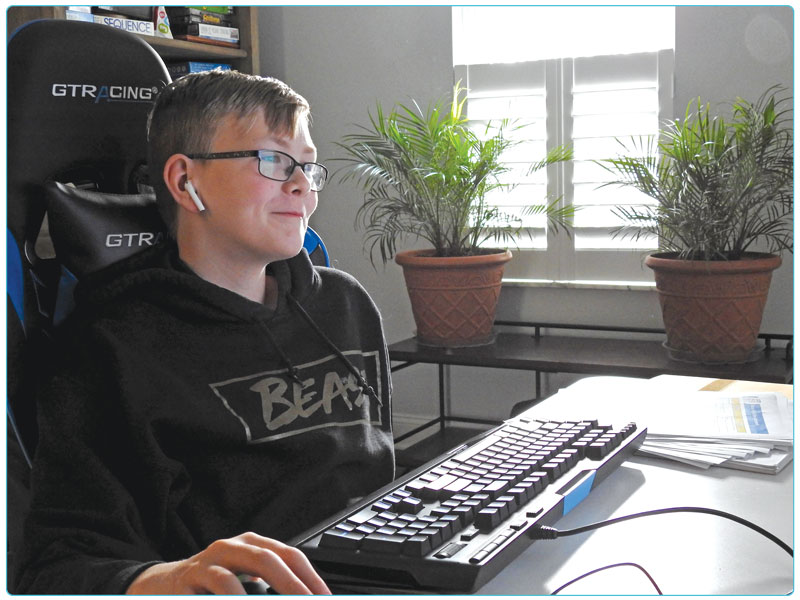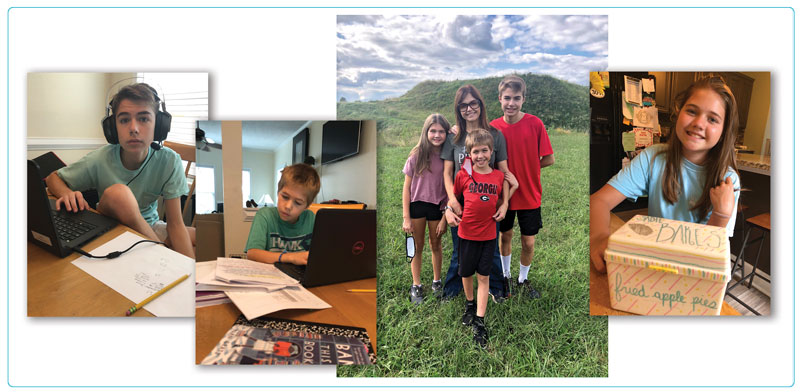Some Students Have Taken to Remote Learning. They're Thriving, in Fact.
More time, less social pressure, and more flexible scheduling has helped some kids flourish.
 |
Eighth grader Dylan Hogan attending school onlinePhoto by Elizabeth Pagel-Hogan |
A school got underway this fall, Thalia Mostow Bruehl and her husband, Alex, who live in Chicago, didn’t have high expectations for the year.
Their six-year-old daughter, Fox, like millions of other students, would be learning remotely. Her parents made the decision to keep her home from her private school because they would both be working from home and could support her in her learning. Plus, their daughter suffers from anxiety, and they knew attending school during a pandemic would be stressful for her. “We also knew, in making this decision, that there was a good chance that she’d end up behind this year, and we were just prepared for that,” says Bruehl. “We both had this point of view that most kids in the world are probably going to be a bit behind academically, and so, if we could help our community by keeping her home as well as benefiting her emotionally, that was an easy decision for us.”
But then they noticed something surprising.
“Suddenly my daughter’s ahead in reading, and her math is really good. And, she’s gaining confidence,” says Bruehl.
Kids like Fox are by far the minority. Overall, distance learning tends to pose many challenges to students, particularly those who are younger and who have learning differences. Students from low-income families who lack reliable internet service and quiet places for doing work have struggled in virtual classrooms.
But a subset of students is thriving in this environment, earning better grades, and improving executive functioning. Why are these kids doing well when so many are floundering?
“It really depends on the kid,” says Denise Pope, a senior lecturer at the Graduate School of Education at Stanford. “I’ve seen different kids thriving at home for different reasons.”
Pope, who holds a PhD in education, says that learning at home can be a welcome reprieve for kids who have experienced unpleasant social interactions at school.
Elizabeth Pagel-Hogan says that’s the case for her 13-year-old son, Dylan, who is attending his Pittsburgh area school’s online academy this year.
 |
Denise PopePhoto courtesy of Challenge Success |
Fewer social stressors
“Some of the typical social anxieties and stressors that middle schoolers face—he doesn’t have to deal with them right now,” says Pagel-Hogan. “And, he can choose who he spends his time with. Middle schoolers don’t often get that choice.”
In addition to an improved social scene, Dylan likes the self-pacing of online learning.
“I think the thing that I like most is that I’m able to work ahead on a lot of my [assignments],” says the academically gifted eighth grader. “I work one day ahead so that I can have a three-day weekend.”
That’s not something Pagel-Hogan says she or her husband pushed him to do.
“I really had no expectations that Dylan was going to do so great,” says Pagel-Hogan. “I just really wanted us to get through the year, but he has amazed me. It’s not just mastery of the material. It’s time management, project management, responsibility, maturity.”
Jessica Airman says she’s seen similar changes in her children, ages 14, 12, and 10.
“I feel like my kids are kind of ready for college, because they had to learn some organizational skills earlier than they would have,” says Airman, a library media specialist at Due West Elementary in Marietta, GA.
When distance learning first began, Airman created a checklist to help her kids, who are academically gifted, keep up with their assignments. She says this was particularly helpful for her older children, Nate and Sadie.
Sadie was overwhelmed at first, but eventually the seventh grader figured it out and mastered time management, a skill “that you don’t oftentimes learn until you’re in high school or college and really have to buckle down.”
Both of Airman’s sons have attention deficit/hyperactivity disorder, or ADHD, but that didn’t prevent them from doing well with distance learning.
Pope has seen this play out with some other students who have trouble paying attention. For them, being at home means “fewer distractions” and “fewer kids around you to get your mind off academics.”
Online learning also helped Airman’s youngest child become more self-confident. Carter is in fourth grade and also has dyslexia. Through distance learning, he has learned to speak up and seek help by emailing his teacher if he needs it.
“Sometimes he would be shy about that, because he wasn’t used to emailing and feeling like that was something he could do, so he had to build his assertiveness,” says Airman.
Now her kids are back in school on a hybrid schedule. But the skills they gained while learning remotely are still serving them well, she says.

“Those skills are making them all more organized with their assignments, and the technology skills are still there,” says Airman. “And their teachers are still using those kinds of assignments. It’s just there’s more support when they’re doing them at school.”
Sarah Walker Caron lives in the Bangor, ME, area with her 12-year-old daughter, who is in eighth grade, and 15-year-old son, who is in tenth grade.
She praises her children’s teachers for giving them the boost they need to succeed at online learning. “They both really want to learn,” says Caron. “I think that’s an important element to have, and having teachers working so hard to make sure they are learning is the other part of it.”
Caron mentions a time when her daughter, who is usually on top of assignments, forgot to turn something in. Her teacher emailed them both to check up on it.
Virtual academic success comes from “a combination of those two things: teachers who are very on top of it and students who are very on top of it,” says Caron.
Bruehl, while watching Fox blossom during distance learning, also praises her child’s teacher.
“The school is really making a point of the kids getting one-on-one time with the teacher,” says Bruehl. “One of the biggest differences between learning last year and learning this year is three times per week, she gets 20 minutes with her teacher. They sit and they read together; they do math together.”
Fox attends a Montessori school that called on parents to set aside a dedicated place for students to work at home, something that would be a hardship for some families. The school also developed an online program over the summer that was designed to mimic what kids would typically do in the classroom.
“I can see the care that was put into making this feel good for them,” says Bruehl. “They do check-ins every Friday, emotional health check-ins, and every week Fox says she feels great and she loves school.”
Before the pandemic, Caron was going to work every day as a newspaper editor, and her kids were busy with school and lots of extracurricular activities.
She has been working at home since the pandemic hit and says having her kids learn at home has given them more quality time together as a family, particularly on days when their schedules align.
“We can all sit down and catch up in the middle of the day and have a nice hot lunch together,” says Caron. It’s just nice to be able to do that and to have that flexibility in our day. It’s time we wouldn’t have had otherwise.”
 |
Media specialist Jessica Airman (above, center) and her three childrenPhotos courtesy of Jessica Airman |
“What is learning?”
Pope notes that having more time and more flexible scheduling has helped some kids thrive during distance learning. This particularly comes into play with older students who no longer have to get up so early for classes.
“I can’t attest that they’re learning better, but they’re definitely getting more sleep, which we know is connected to better well-being, better mental health, and better physical health,” said Pope. “I am hearing from older kids [that] much as they miss their friends or their extracurriculars, they are getting better grades because they’re less overextended.”
While distance learning has taken off during the pandemic, many districts have been offering some form of it for a while. With the success their kids are having, some families are considering it as an option once things return to normal.
Pagel-Hogan says her family is in that boat, even though they’re not sure how it would work as Dylan transitions to high school.
“Online schooling has really opened my eyes,” says Pagel-Hogan, who is now looking at education differently. “What is learning? Is it memorization of facts and dates? Or, is it developing that questioning analytical mind? And, so, it’s reframed a lot of my thoughts and expectations for my kids.”
Caron is planning to send her kids back. “While it is working, and they are learning, this is not something we ever want to do again,” says Caron. “There is a lot to be gained from being in an in-person environment. My kids prefer to be in the classroom, and I prefer them to be in the classroom.”
Pope stresses that it’s important to remember that most kids have struggled with distance learning. But since there is no one-size-fits-all approach when it comes to education, families who have found success with online learning may want to look into that long-term.
“There’s no reason that your kid needs to go back to an in-person school, if they’re thriving right now, because there are those options,” says Pope. “Not everybody has to learn the same way.”
When the pandemic eventually ends and kids begin to head back to school buildings en masse, will any of the lessons learned from the students who thrived in distance learning go with them?
Pope hopes so. In addition to teaching at Stanford, she is also the cofounder of Challenge Success, a nonprofit that works with educators and parents to balance student well-being and academic achievement.
She says that throughout the pandemic, Challenge Success has been encouraging educators to pay attention to students’ social and emotional needs and watch out for cyber bullying.
“We always talk about the need to connect with kids, the need to check in, the need to try to have at least short one-on-one meetings,” says Pope. “These are things that we’ve been saying for years and years, but what we found is, since March 2020, more teachers understand that.”
Marva Hinton is a contributing editor of Edutopia and the host of the “ReadMore” podcast.
RELATED
The job outlook in 2030: Librarians will be in demand
The job outlook in 2030: Librarians will be in demand
ALREADY A SUBSCRIBER? LOG IN
We are currently offering this content for free. Sign up now to activate your personal profile, where you can save articles for future viewing






Add Comment :-
Comment Policy:
Comment should not be empty !!!
Lindy Olson
Thank you for this. I've felt almost guilty that my 2E middle schooler is doing so well with distance learning while so many other kids are struggling. But I attribute his success to better sleep and the lack of social stressors, as you mentioned. Great article!
Posted : Mar 15, 2021 05:30